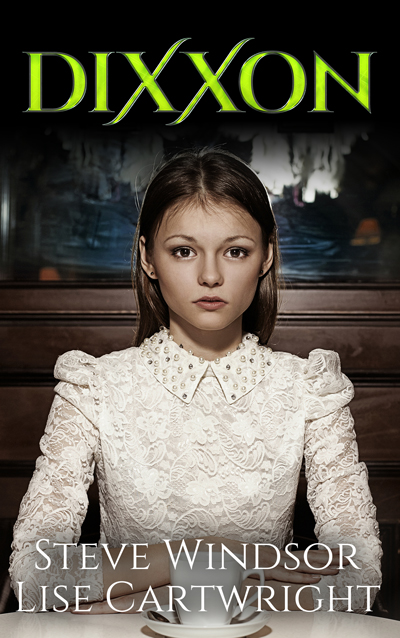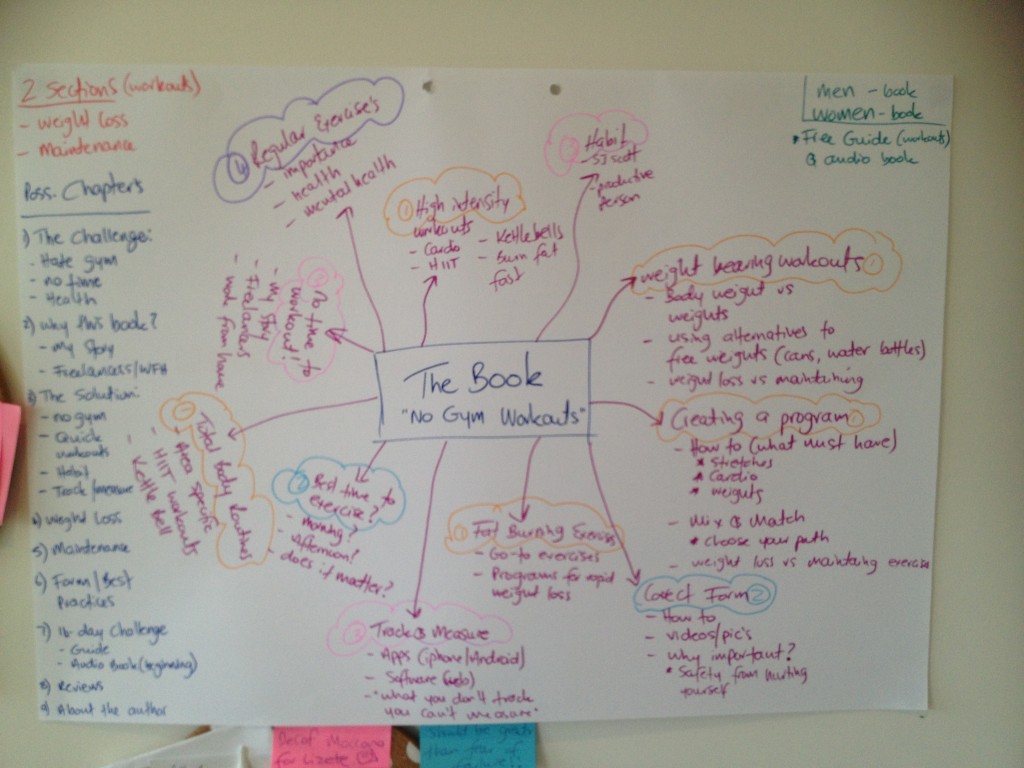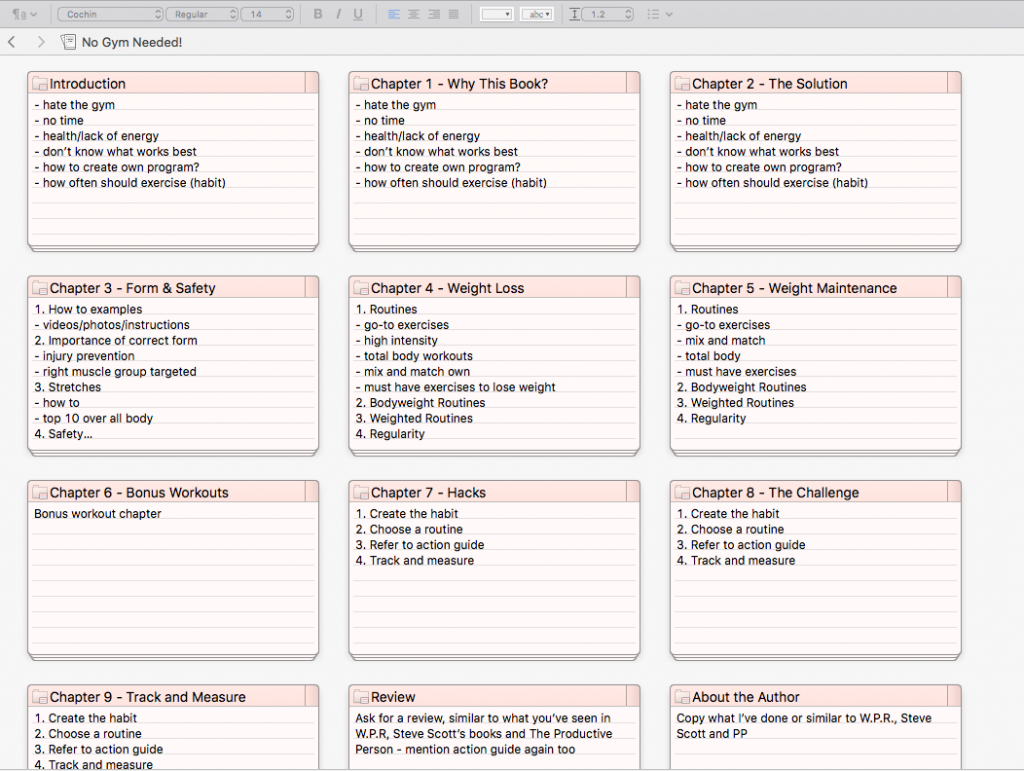If you’re anything like Steve and I, you’ve got book ideas coming at you on a daily basis. Capturing those book ideas is one thing, turning them into an actual book is another.
One of the keys to our book publishing success is in being able to get your books written and published quickly. Of course, there is no compromise on the quality of the books we produce, we’ve just learned to be smart about the process.
A major component of our book writing process revolves around the idea of mindmapping and outlining.
And that’s what we’re talking about today. We want to show you what we do, plus highlight a few other ways as well, so that if you’re struggling to get that idea into a published book, this post will help.
Mindmapping a Book
This is my go-to when writing any non-fiction book. I start with a mindmap. And I don’t use any fancy schmancy software to create my mindmap either — I use good ole’ fashioned pen and paper… colored pens to be exact.
My process goes something like this:
- I review my Evernote notebook for ideas and choose one to start with (I have close to 30 book ideas at any given time, and have a schedule to get at least 10 written this year!).
- Once I’ve got the main idea, I grab a poster sized piece of paper, some colored pens and write the main idea in the centre of the page, in a little bubble to signify to me that it’s the main idea.
- Then I sit and stare at this idea for a good 10 minutes, while I let thoughts swirl around in my head that relate to the idea.
- After this time, I grab colored pens and just write everything down that I’m thinking. It get’s messy and confusing, but this is the whole point of the mindmap, to just free write and get everything out of my head and down on paper.
- I’ll spend about 2 hours doing this, taking breaks as needed. I’ll then let it marinate for another 24 hours, where I put the mindmap up on my wall and glance at it throughout the following day. 24 hours later, I’ll come back to it and add more ideas.
- Then my mindmapping process is done.
Here’s an example of my first mindmap for my book, No Gym Needed:
As you can see, it’s messy! Just the way I like my mindmap to be 😉
Once this process is finished, it’s time to move on to grouping similar ideas together.
Basically, you look at your first mindmap and then start grouping similar ideas together, as I did below with NGN:
You can also see that I had a working title as well, which obviously changed and morphed into No Gym Needed. But that’s a whole other blog post discussion topic…
Outlining Using Scrivener
Once you’ve got this mindmap in place, you can then start to identify chapters and start to see your book coming together. It’s at this point I’ll fire up Scrivener and start my rough outline. Again, using the NGN example, this is how it looked inside Scrivener before I started writing it!
This whole process works really well for me and once the outline is in Scrivener, it makes my writing process so much easier.
Imagine opening your computer at 5am in the morning, firing up Scrivener and being met with this outline. How easy is it to simply click on a chapter and start writing based on the cliff notes you’ve got written right inside Scrivener…?
It’s super easy and it’s how I’ve managed to write and publish over 20 books in the last 18 months.
Butt in chair, fingers on keyboard and typing away also play a small part in the equation too 😉
So that’s my process for a non-fiction book.
Now, for a fiction book, things are a little different… and with Steve and I co-authoring a book together at the moment, our approach is probably a little different than if you were writing a book by yourself…
Outlining Our Fiction Book – Dixxon
 When we decided that we’d sit down and co-author a book together, we had no idea how it was gonna work. We looked to the guys at Realm & Sands for some ideas, and decided that the best way for us to get started was to jump on a Google Hangout, record our discussion and start from there.
When we decided that we’d sit down and co-author a book together, we had no idea how it was gonna work. We looked to the guys at Realm & Sands for some ideas, and decided that the best way for us to get started was to jump on a Google Hangout, record our discussion and start from there.
This resulted in over 4 hours of brainstorming, jumping around from plot line to character development; but it allowed us to come up with a pretty solid outline to write Dixxon with.
We started with the 4-Part Story Structure as our framework, discussing ideas in each part and writing everything down in a shared Google Doc.
Nearly 10 months later, and we’re now in the process of writing the book (currently on the second draft as we speak!), that recording and Google Doc have been absolutely amazing to go back to and watch/read. It has made this whole process a lot easier, because we had fleshed out the storyline quite a bit.
So if you’re thinking about writing a fiction book, consider recording your brainstorming session. You don’t have to be co-authoring with someone else to record yourself.
Record yourself using a Google Hangout or use software like Screencast-o-matic.
These are just a couple of options you could use to mindmap and outline your next book. How do you outline your book? We’d love to hear your thoughts, so don’t forget to pop something in the comments below!





